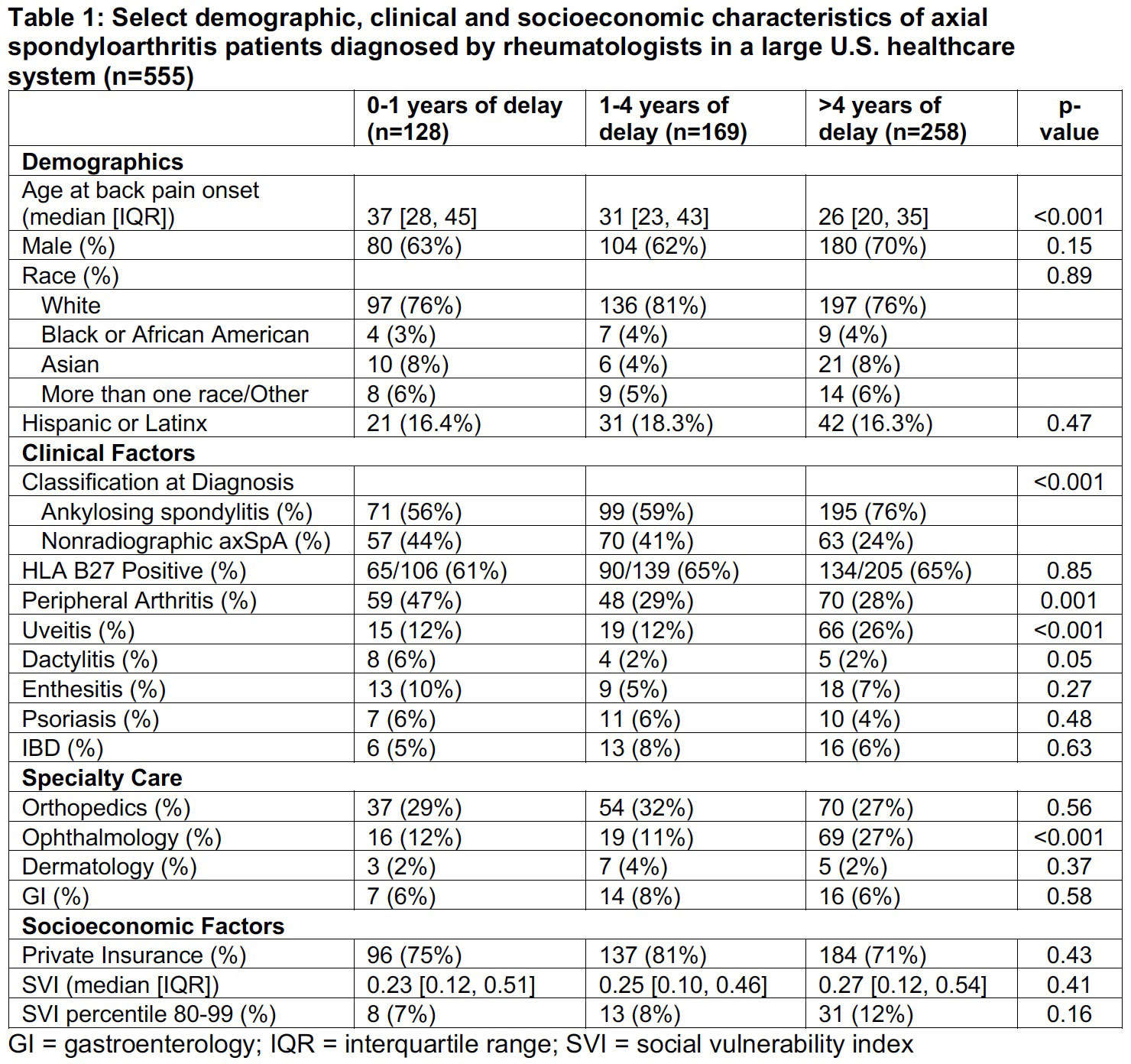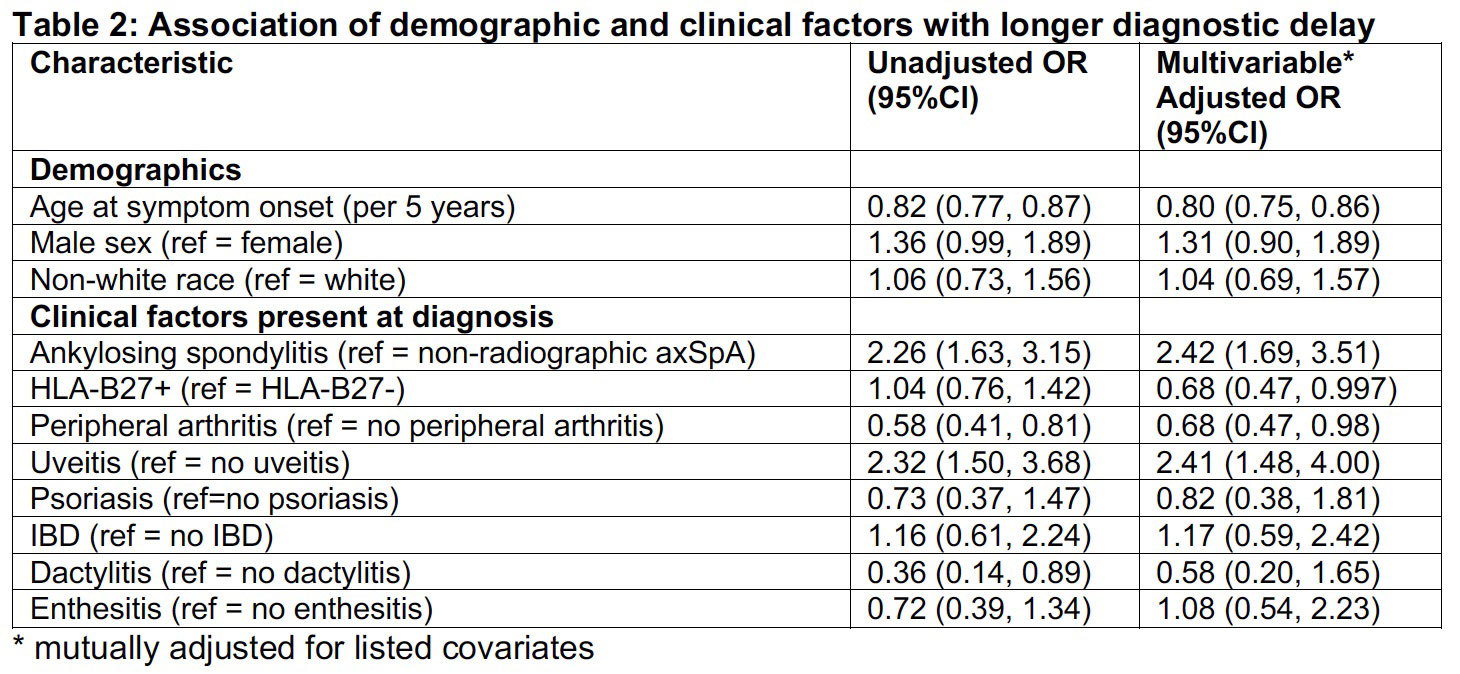Session Information
Date: Saturday, November 12, 2022
Title: Spondyloarthritis Including PsA – Diagnosis, Manifestations, and Outcomes Poster I
Session Type: Poster Session A
Session Time: 1:00PM-3:00PM
Background/Purpose: Patients with axial spondyloarthritis (axSpA) experience significant delay between symptom onset and diagnosis. Determinants of delay are incompletely understood. We investigated the associations between demographic, medical and socioeconomic factors and axSpA diagnostic delay.
Methods: We identified patients with axSpA diagnosed by rheumatologists in a large, multihospital healthcare system between December 1990 and October 2021. We used a published electronic health record (EHR) screening algorithm and medical record review to select patients who met modified New York criteria for ankylosing spondylitis (AS) or 2009 ASAS classification criteria for axSpA. Diagnostic delay was determined based on the duration of back pain that patients reported at diagnosis. We reviewed the EHR to determine specialty care and disease manifestations at or prior to diagnosis. We mapped patient addresses to US census tract and determined their social vulnerability index (SVI) by referencing the 2018 US Centers for Disease Control SVI Atlas. SVI is an area-level composite measure of poverty, lack of access to transportation, crowded housing and household income. Consistent with prior research, we considered patients in the 80-99th SVI percentiles nationally to have the highest level of vulnerability. We categorized duration of delay (0-1, 1-4, or >4 years) and investigated differences between groups using Kruskal-Wallis and chi-squared tests. We examined the association between disease manifestations and SVI on diagnostic delay using ordinal logistic regression adjusted for demographic and clinical factors.
Results: We included 555 patients with new axSpA diagnosis in our healthcare system. The mean diagnostic delay was 6.8 +8.5 years (median 3.8). Groups with longer delay were younger at symptom onset (median age 29 vs 31 vs 37 years in the >4 years, 1-4 years and 0-1 year delay groups, respectively). Those with >4 years of delay were more likely to seek ophthalmology care for uveitis prior to diagnosis (27% vs 12%, Table 1). In multivariable ordinal logistic regression analyses, AS at diagnosis (OR 2.42, 95%CI 1.69-3.48) and uveitis history (OR 2.43, 95%CI 1.50-4.02) were associated with longer diagnostic delay. HLA-B27 positivity (OR 0.68, 95%CI 0.47-0.997), peripheral arthritis (OR 0.68, 95%CI 0.47-0.99) and older age at symptom onset (OR 0.80, 95%CI 0.75-0.86 per 5 years) were associated with shorter delay. The 80-99th percentile of SVI was associated with longer diagnostic delay (OR 1.96, 95%CI 1.04-3.84) after adjustment for demographic and clinical factors (Table 3).
Conclusion: We identified several clinical and socioeconomic factors that may influence diagnostic delay in axSpA. Older age at back pain onset, peripheral arthritis and positive HLA-B27 were associated with shorter delay. In contrast to other disease manifestations, uveitis was more common among patients with >4 years of diagnostic delay and nearly one third of this group sought ophthalmology care prior to diagnosis. Patients with higher socioeconomic vulnerability had longer diagnostic delay independent of clinical factors. These findings may help identify education and screening strategies to facilitate timely axSpA diagnosis.
To cite this abstract in AMA style:
McDermott G, Selzer F, Zhao S, Ermann J, Katz J. Factors Associated with Diagnostic Delay in Axial Spondyloarthritis: Impact of Clinical Factors and Social Vulnerability [abstract]. Arthritis Rheumatol. 2022; 74 (suppl 9). https://acrabstracts.org/abstract/factors-associated-with-diagnostic-delay-in-axial-spondyloarthritis-impact-of-clinical-factors-and-social-vulnerability/. Accessed .« Back to ACR Convergence 2022
ACR Meeting Abstracts - https://acrabstracts.org/abstract/factors-associated-with-diagnostic-delay-in-axial-spondyloarthritis-impact-of-clinical-factors-and-social-vulnerability/



